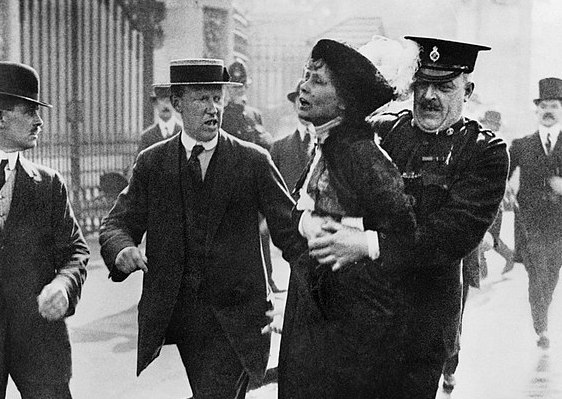
No place for a woman? Emmeline Pankhurst, leader of the women’s suffragette movement, is arrested outside Buckingham Palace while trying to present a petition to King George V in May 1914 (Photo Imperial Warm Museum)
IN LIGHT of US President Donald Trump’s reputation for lewd remarks about women, it is fitting that a bare-breasted woman chased his motorcade on the Champs d’Elysées in Paris on Sunday, en route to events marking the centenary of the First World War Armistice. The words “Fake Peacemaker” were written on her chest.
Theatrics aside, we live in a chilling era, when the world’s most powerful man is told to rein himself in by a topless woman because his actions and language evoke the kind of foolish nationalism which led to the First World War between 1914 and 1918. Some 9.7 million soldiers and 10 million civilians died in that war. Rational people watch with alarm the drift towards aggressive nationalism today.
Women using their bodies for politics is not new. It’s a potent weapon capable of moving a male-dominated domain. English suffragettes in the First World War era demanded voting rights for women by chaining themselves to railings, storming parliament and battling police. They wore long dresses appropriate to the time. When imprisoned, they went on hunger strikes, leading the government to force-feed them. After the First World War parliament gave women over age 30 the vote under certain qualifications, and ten years later full electoral equality with men.
Their campaign had a Jewish thread. In November 1912, female Jewish leaders founded the Jewish League for Woman Suffrage, linking feminist goals with Jewish loyalties, aiming to unite Jewish suffragettes of all shades of opinion.
South African women have used their bodies for dramatic statements, particularly about violence against women. According to the World Health Organisation, South Africa’s 2016 femicide rate was 12.1 per 100,000, almost five times higher than the global average of 2.6 per 100 000. Statistics SA reports that 138 per 100,000 women were raped in 2017, also the highest rate in the world. The number is probably higher, with a large percentage of rapes going unreported. According to a SAPS report of 2018, femicide increased by 11% over the last two years.
It’s incredible that a country which was the darling of the world two decades ago, contains such poison. People fighting back have a bitter struggle. At a Gender-based Violence and Femicide Summit in Irene at the beginning of November, attended by President Cyril Ramaphosa and more than 1000 delegates, women survivors of sex trafficking, rape, abuse, and violence recounted the horrors and demanded stronger laws.
What courage it must take for a woman to bare herself publically as a gesture about the society’s sickness. Phindile Ncube did it. Speaking from the podium, she said she was kidnapped, kept in a house in Tembisa and raped by a gang of eight men over several days. As a result, she had to undergo five surgical operations on her stomach – including one procedure to remove plastic that had been inserted in her.
She spoke emotionally of the desperate pain of seeing her attackers back on the streets after serving only four years in prison – again, an incredible indictment of the society. How did we come to this?
Then, in a shocking move, Ncube lifted her dress, wearing nothing underneath, exposing her body for all – including Ramaphosa – to see the scars. Audience members covered their eyes at the spectacle. Facing the president she said: “I was not born like this, this came as a result of my attackers, and I have to carry the scars while they walk free… Our lives can’t be paroled Mr President, the minimum sentence for sex offenders must be at least 50 years.”
Some people would say even 50 years is not enough.
GEOFF SIFRIN is a journalist in Johannesburg, South Africa, and former Editor of the SA Jewish Report. Email: geoffs@icon.co.za